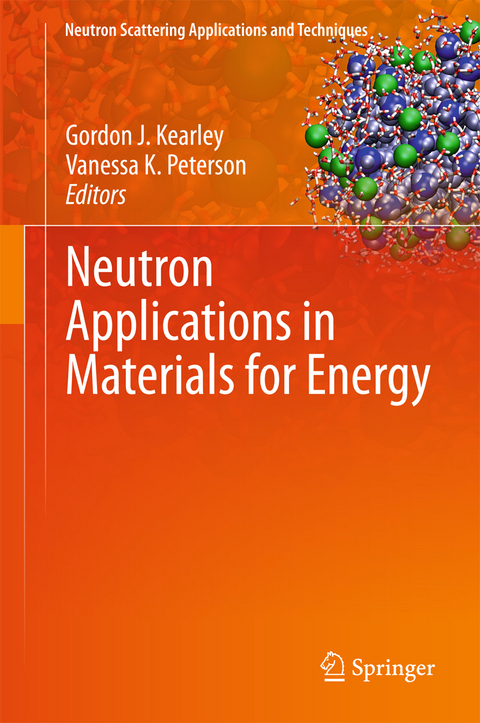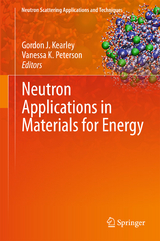Neutron Applications in Materials for Energy
Springer International Publishing (Verlag)
978-3-319-06655-4 (ISBN)
Neutron Applications in Materials for Energy collects results and conclusions of recent neutron-based investigations of materials that are important in the development of sustainable energy. Chapters are authored by leading scientists with hands-on experience in the field, providing overviews, recent highlights, and case-studies to illustrate the applicability of one or more neutron-based techniques of analysis. The theme follows energy production, storage, and use, but each chapter, or section, can also be read independently, with basic theory and instrumentation for neutron scattering being outlined in the introductory chapter.
Whilst neutron scattering is extensively used to understand properties of condensed matter, neutron techniques are exceptionally-well suited to studying how the transport and binding of energy and charge-carrying molecules and ions are related to their dynamics and the material's crystal structure. These studies extend to in situ and in operando in some cases. The species of interest in leading energy-technologies include H2, H+, and Li+ which have particularly favourable neutron-scattering properties that render these techniques of analysis ideal for such studies and consequently, neutron-based analysis is common-place for hydrogen storage, fuel-cell, catalysis, and battery materials. Similar research into the functionality of solar cell, nuclear, and CO2 capture/storage materials rely on other unique aspects of neutron scattering and again show how structure and dynamics provide an understanding of the material stability and the binding and mobility of species of interest within these materials.
Scientists and students looking for methods to help them understand the atomic-level mechanisms and behaviour underpinning the performance characteristics of energy materials will find Neutron Applications in Materials for Energy a valuable resource,whilst the wider audience of sustainable energy scientists, and newcomers to neutron scattering should find this a useful reference.
Prof Don Kearley received his PhD from the University of East Anglia, UK, worked at the Institut Laue-Langevin in Grenoble, France, became Chair of Radiation Physics at Delft University of Technology, the Netherlands, and is presently Senior Researcher in the Neutron Scattering Group at the Bragg Institute of ANSTO (Australian Nuclear Science and Technology Organization). He has a fair experience of most neutron-scattering techniques, particularly inelastic and quasielastic methods. Currently most of his work is in providing modelling support for the neutron scattering activities of scientists at the Bragg institute and elsewhere, which is usually in the form of understanding the underlying mechanism in function. Dr Vanessa Peterson is a Senior Research and Instrument Scientist at ANSTO (Australian Nuclear Science and Technology Organization). Her expertise includes structure and dynamics in chemistry and their relationship to properties in condensed matter materials including cement, porous coordination framework materials, and hydrogen storage materials. She has also great expertise in analyses techniques like Synchrotron/Laboratory X-Ray and Neutron Powder Diffraction, Rietveld analysis, Quasi-Elastic Neutron Scattering, Inelastic Neutron Scattering, and Single Crystal X-Ray Diffraction.
Preface.- Glossary.- 1 Neutron Applications in Energy Materials Research.- Part I Energy Generation.- 2 Catalysis.- 3 CO 2 Separation, Capture, and Storage in Porous Materials.- 4 Materials for the Nuclear Energy Sector.- 5 Solar Cells: Chalcopyrite Thin Film Devices.- 6 Solar Cells: Organic Devices.- Part II Energy Storage.- 7 Li-ion Batteries.- 8 Hydrogen Storage Materials.- Part III Energy Use.- 9 Fuel Cells: Neutron Scattering of Proton-Conducting Ceramics.- 10 Fuel Cells: Neutron Techniques as a Probe of Structure, Dynamics and Transport in Polyelectrolyte Membranes.
"Gordon J. Kearley and Vanessa K. Patterson have edited a remarkable and long due book in the Springer series Neutron Scattering Applications and Techniques. In the newest issue on the topic of energy materials contributions from some of the leading neutron scatterers in this field have been gathered. ... this book demonstrates the power of neutron scattering and imaging for energy research and thus represents an important tool to bridge the gap between neutron scattering specialists and energy researchers." (Joel Mesot, Neutron News, Vol. 26 (4), 2015)
| Erscheint lt. Verlag | 5.2.2015 |
|---|---|
| Reihe/Serie | Neutron Scattering Applications and Techniques |
| Zusatzinfo | X, 306 p. 166 illus., 81 illus. in color. |
| Verlagsort | Cham |
| Sprache | englisch |
| Maße | 155 x 235 mm |
| Gewicht | 27 g |
| Themenwelt | Technik ► Elektrotechnik / Energietechnik |
| Schlagworte | Cathode Materials and Solid Electrolytes • Cationic conductivity • Fuel Cell Catalyst • High-Temperature Fuel Cells • Hydrogen conductivity • Hydrogen-related Properties of Matter • Inelastic Incoherent Neutron Scattering • Inorganic Solar-cells • In-situ neutron scattering analysis • intermetallic compounds • Ionic Mobility in Solids • Lattice dynamics and crystallography studies • Neutron-based studies on sustainable-energy materi • Neutron-based studies on sustainable-energy materials |
| ISBN-10 | 3-319-06655-2 / 3319066552 |
| ISBN-13 | 978-3-319-06655-4 / 9783319066554 |
| Zustand | Neuware |
| Haben Sie eine Frage zum Produkt? |
aus dem Bereich




